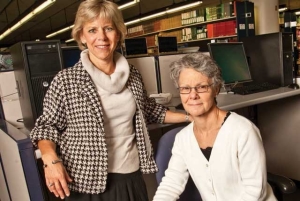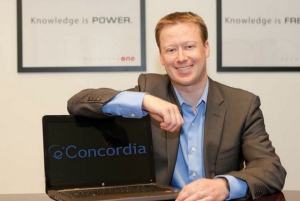Aside from scheduled assessments, students in online classes decide when they want to access course content and what pace they want to go through material. “Many professors realize that in addition to changing their teaching style, there is an added managerial role that comes with online teaching: managing the teaching assistants, making sure that the marking is fair for everyone, and making sure that all the students who are having difficulty are being responded to,” Devey says.
It’s a small part of what we do. We’re not the virtual Concordia space. What we are is in these buildings.
Locke offers support for her online students with a web conferencing platform for e-learning that allows students to ask questions in a live, online setting and receive immediate feedback from the instructor. She admits that at first she was nervous using the new technology yet now appreciates that it allows an immediate connection with students.
Wade adds professors must be aware that setting up an effective online course requires a major time investment up front: “You’re not simply digitizing the course materials but are adapting them so that you can have interactive content, making it interesting by moving from one medium to another.”
To ensure the quality of online courses, Concordia decided to hold final exams for its online courses in an invigilated environment, which could be a challenge given the size of some classes. Wade and Locke explain that they also designed their course to make it a comprehensive process; its final exam builds directly upon work done throughout the semester.
It’s perhaps no surprise that online learning is becoming more popular — it offers students the chance to tap into top-quality education from anywhere, at any time. For the fall 2013 semester, eConcordia expects to reach 35,000 enrolments — up from 12,375 six years ago. Devey predicts further growth. “Students are increasingly interested in this mode of learning. They like the flexibility,” he says. “And it’s becoming more and more accepted by the academic community as a viable alternate to classroom-based instruction.”
As for Wade and Locke’s course, they reached the maximum number of 100 students the first semester it was offered. That limit was removed in winter 2012 and resulted in 197 enrolments; in winter 2013, some 212 students registered and 201 completed it, which Locke says is a significantly high retention rate. For future semesters, both professors agree they will place more emphasis on interaction with students using various tools, such as a discussion board and web conferencing sessions.


 Anne Wade (left) is manager and information specialist at Concordia’s Centre for the study of learning and performance, and Joanne Locke is interim dean of the Faculty of Arts and Science. Enrolment for their online course doubled after they removed its limit.
Anne Wade (left) is manager and information specialist at Concordia’s Centre for the study of learning and performance, and Joanne Locke is interim dean of the Faculty of Arts and Science. Enrolment for their online course doubled after they removed its limit.
 Patrick Devey is chief learning officer of Concordia’s e-learning provider Knowledgeone. He says that while most professors enjoy moving their courses online, he points out that instructors need to exercise patience during the course-design process since most are entering an unfamiliar field.
Patrick Devey is chief learning officer of Concordia’s e-learning provider Knowledgeone. He says that while most professors enjoy moving their courses online, he points out that instructors need to exercise patience during the course-design process since most are entering an unfamiliar field.